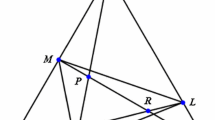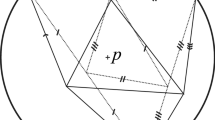Abstract
We give rigorous, computer assisted proofs of a number of statements about the effect on the volume of lengthening various edges of a tetrahedron. Our results give new and sharp polynomial inequalities concerning the Cayley–Menger determinant and its partial derivatives.






Similar content being viewed by others
References
Bezdek, K., Connelly, R.: Pushing disks apart—the Kneser-poulsen conjecture in the plane. Journal fur die riene und angewandte Mathematik. 553, 221–236 (2002)
Luo, F.: \(3\)- Dimensional Schlafli formula and its generalizations. arXiv:0802.2580
Pak, I.: The Cayley–Menger determinant, UCLA course notes (2006) http://www.math.ucla.edu/~pal/courses/geo/cm.pdf
Rivin, I.: Some Observations on the Simplex, preprint (2003) arXiv:math/0308239v1
Sabitov, IKh: Algebraic methods for solution of polyhedra. Russ. Math. Surv. 66(3), 445–505 (2011)
Schwartz, R.: The Projective Heat Map on Pentagons, research monograph (2014) preprint
Wells, J.H., Williams, L.R.: Embeddings and Extensions in Analysis. Springer, Berlin (1975)
Wolfram, S.: Mathematica. Wolfram Media and Cambridge University Press, Illinois (1999)
Author information
Authors and Affiliations
Corresponding author
Additional information
Supported by N.S.F. Research Grant DMS-1204471.
Appendix: Existence in all dimensions
Appendix: Existence in all dimensions
Here I’ll give the proof of Theorem 1.2. I learned all the arguments here from Peter Doyle and Igor Rivin. Let \(D\) stand for a list \(\{d_{ij}\}\). We will perform operations componentwise, so that \(D+t=\{d_{ij}+t\}\), etc. We define tetrahedral lists in all dimensions just as in the \(3\) dimensional case. Let \(T\) denote the space of tetrahedral lists.
Theorem 6.1
If \(D \in T\) then \(\sqrt{D} \in T\).
See [7, Corollary 4.8]. In [7] this result is attributed to Von Neumann, though Rivin calls it Schoenberg’s result.
Theorem 6.2
If \(A,B \in T\) then \(\sqrt{A^2+B^2} \in T\). The simplex represented by \(\sqrt{A^2+B^2}\) has larger volume than the simplex represented by \(A\).
Proof
See [4] for a proof. See also [1, Lemma 1]. Here is a self-contained proof.
Given a quadratic form \(Q\) and a linear isomorphism \(L\), we have the new quadratic form
Let \(\Delta \subset {{\varvec{R}}}^n\) denote some copy of the regular simplex. Let \(L_A\) denote the linear transformation which carries \(\Delta \) to a simplex \(\Delta _A\) whose lengths are realized by \(A\). Let \(Q_A\) be the quadratic form such that \(L_A^*(Q_A)\) is the standard quadratic form—i.e. the dot product. By construction, \(Q_A\) assigns the length list \(A\) to the sides of \(\Delta \). Likewise define \(Q_B\). The sum \(Q_C=Q_A+Q_B\) is also positive definite. Given an edge \(e\) of \(\Delta \). Let \(C\) denote the list of lengths that \(Q_C\) assigns to \(\Delta \). We compute
This shows that \(Q_C\) assigns the corresponding number on the list \(\sqrt{A^2+B^2}\) to the edge \(e\). But then let \(L_C\) be the linear transformation which pushes \(L_C\) forward to the standard quadratic form. By construction \(L_C(\Delta )\) is the simplex realizing the list \(\sqrt{A^2+B^2}\).
Note that \(L_C(e)>L_A(e)\) for all \(e \in {{\varvec{R}}}^n\). But then the linear map carrying \(\Delta _A\) to \(\Delta _C\) strictly increases all distances, and hence also increases volume. \(\square \)
Let \(\phi _t\) denote the lengthening flow. That is, \(\phi _t(D)=D+t\). Let \(D_t=\phi _t(D)\).
Lemma 6.3
for all \(D \in T\).
Proof
Choose some point \(D \in T\). By Theorem 6.1 and scaling, \(\sqrt{2tD} \in T\). By Theorem 6.2. \(\sqrt{D^2+2tD} \in T\). But we can write out
Theorem 6.2 shows that
Taking the limit as \(t \rightarrow 0\) we get the result of this lemma. \(\square \)
Lemma 6.3 implies that \(D_t \in T\) for all \(t\), because \(\mathrm{vol}(D_t)\) cannot converge to \(0\). This takes part of the existence statement in Theorem 1.2.
To see that \(\mathrm{vol}(D_t)\) is strictly increasing, we look more carefully at the proof of Theorem 6.2. When all the terms on the list \(B\) have size \(O(t)\), and \(t\) is much smaller than the minimum length on the list \(A\), the quadratic form \(Q_C\) assigns the length \(A_e+O(t)\) to each unit length vector \(e \in {{\varvec{R}}}^n\). But then the linear map \(\Delta _A\) to \(\Delta _C\) increases all unit distances by \(O(t)\), and hence increases volume by \(O(t)\) as well. This gives
for some positive constant \(C_D\). Taking the limit, we see that \(\mathrm{vol}(D_t)\) is strictly increasing, and in fact has positive derivative. This completes the proof of Theorem 1.2.
Rights and permissions
About this article
Cite this article
Schwartz, R.E. Lengthening a tetrahedron. Geom Dedicata 174, 121–144 (2015). https://doi.org/10.1007/s10711-014-0007-y
Received:
Accepted:
Published:
Issue Date:
DOI: https://doi.org/10.1007/s10711-014-0007-y




